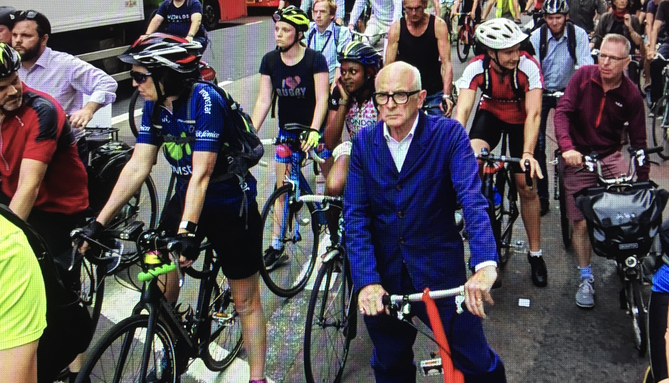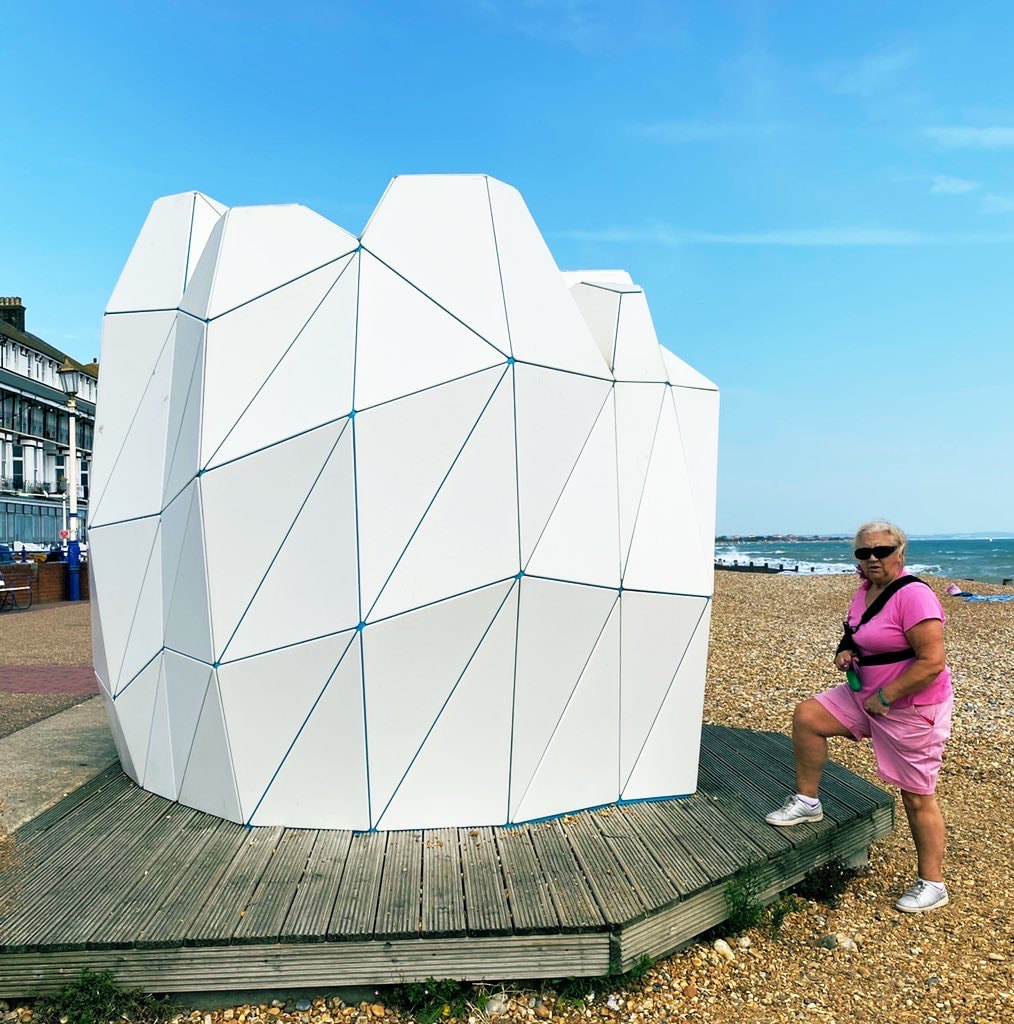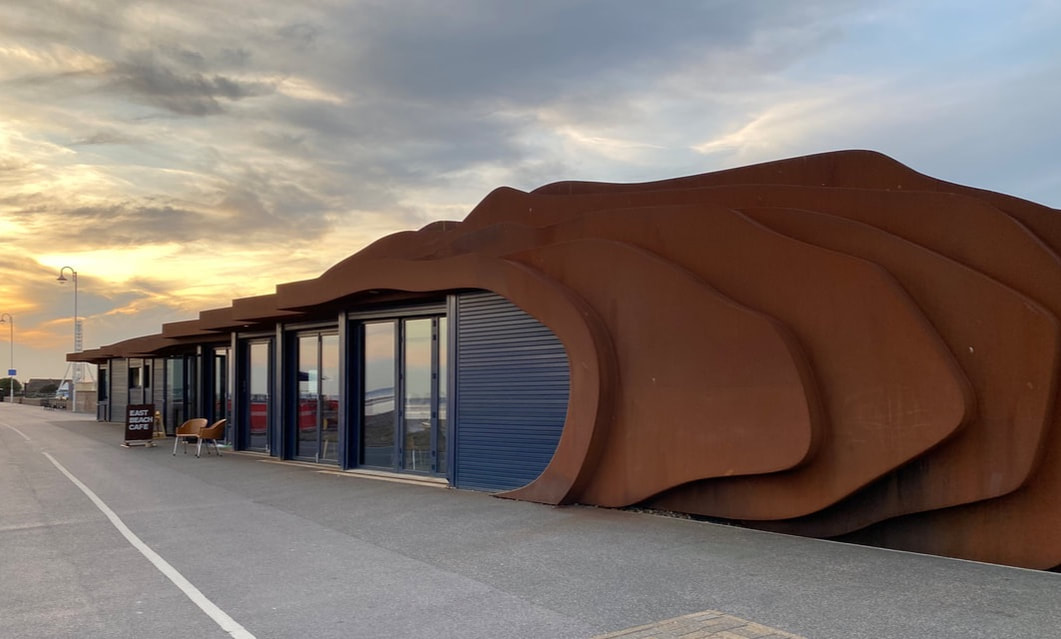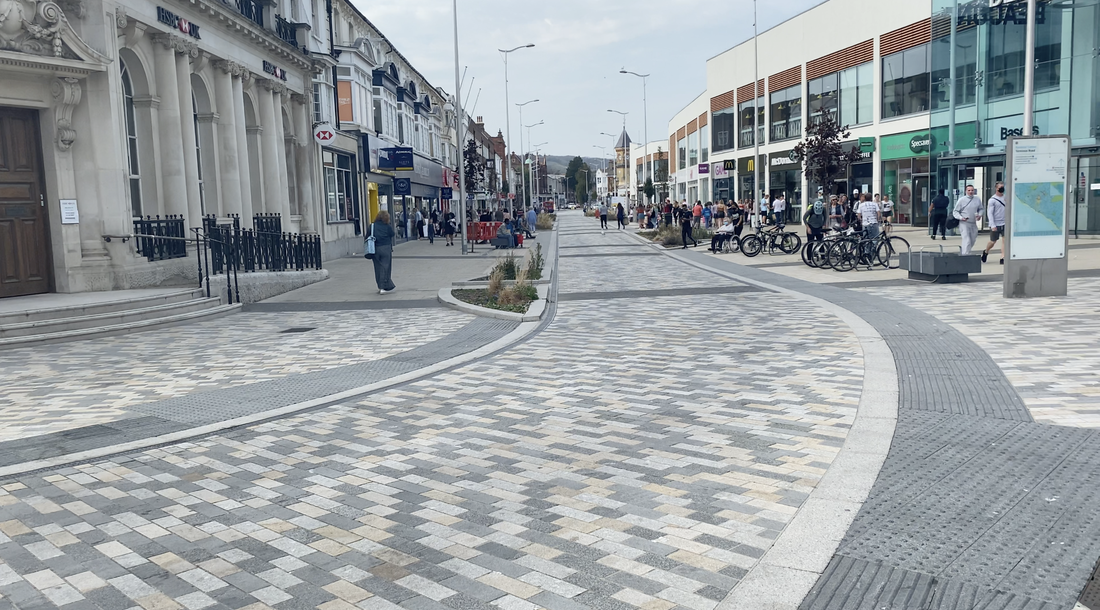|
There were still quite strong headwinds as I left Eastbourne, passing a couple of designer beach huts commissioned by Eastbourne Borough Council as part of a programme to boost visitor numbers. The designs were nice enough but nobody seemed to be maintaining them, which rather spoilt the intended effect. A highpoint of the day’s ride was cycling into Bexhill and seeing the splendid De La Warr Pavilion, designed by Erich Mendelsohn and Serge Charmayeff, commanding the seafront. The building was constructed in 1935 and extensively refurbished by John McAslan in 2006. CABE’s Shifting Sands report celebrated the success of the pavilion’s renaissance which it calls “Crystal Palace by the sea”. The report also mentioned Niall McLaughlin’s “deceptively fragile” mobile bandstand which won a RIBA Award back in 2002. It’s not as fragile as it looks and I am pleased to report that it is in excellent shape having benefitted from a recent wash and brush up. The landscaping by HTA, funded by CABE’s (don’t you miss ‘em?) Seachange programme, elegantly ties the whole lot together. Then on to Hastings where the architectural story is not so rosy. I was looking forward to seeing dRMM’s Stirling Prize-winning pier. I knew it had had financial problems and that the new operator was not that sympathetic to the architects’ concept. But I was shocked at how dRMM’s elegant structure had been disfigured by poorly arranged and badly designed attractions. I realise that the idea was to create a platform that could support a variety of uses from circuses to music events but sadly the architecture is almost totally submerged by the tat. HAT Projects’ black ceramic-clad Jerwood Gallery further along the front, which opened in 2012, has not suffered such depredations and sits comfortably with the pitch-painted net drying towers that serve the town’s fishermen whose mainly under-10m boats make up the UK’s largest beach-launched fleet and fish for cod, skate, sole and plaice. After a 160m climb out of Hastings, the roads were flat, crossing Romney Marsh, Rye Bay and Dungeness. This Special Protection Area runs from Norman’s Bay in the west to Hythe in the east bookended between high chalk cliffs. The area includes the largest and most diverse area of shingle beach in Britain. It was originally formed by rivers draining the Weald to the north whose sediment filled the area behind the shingle beaches over time. Rye is a very pretty town. I haven’t been there for ages and was surprised at the number of visitors and the long traffic queues - a situation probably exacerbated COVID19. It is also a port with facilities for a 32-boat fishing fleet. Some of the catch is sold at the quayside, though most is sold across the channel in Boulogne. In contrast, Dungeness is not very pretty, dominated as it is by pylons and power lines leading to Dungeness B nuclear power station. You weave your way through scrubland and barbed wire fences ending up at Lydd-on-Sea probably the most depressing place on my whole journey so far. A long straight road of ugly bungalows on one side looks out over a hundred metres or so of scrubby shingle that is more like an aggregate quarry than a seaside beach. Things improved hugely, however, as I got to Dymchurch and joined the broad walkway that forms part of the coastal defences which were upgraded in 2011 to protect the town. These are around 5m wide and form a very nice cycling environment with plenty of space for both pedestrians and riders. As I cycle into Folkestone along Marine Drive I am struck by a huge building site on the beach. This turns out to be the Folkestone Harbour and Seafront Development designed by Acme Architects for Sir Roger de Haan - the wealthy philanthropist who has spent many millions supporting the regeneration of his home town. The development company has already invested in works to the harbour and the old rail station, much improving this part of the front which has been in a sorry state ever since the ferry services dwindled away in the late 1990s. Improvements include an open-air cinema, a hub for independent traders as well as restoration of the Customs House, lighthouse and viaduct. In recent years De Haan has been closely involved in bringing the arts and culture to the town, supporting the Creative Folkestone charity which, among other things, manages the Folkestone Triennal. Another plus for the town is the high-speed rail service which means it is possible to get to London St Pancras in a little over 50 minutes. Since it opened in 2009, this has helped to stimulate the local economy and generate new employment opportunities.
Despite all this, some parts Folkestone experience record levels of deprivation; the proportion of households earning less than £20,000 per annum is near twice the national average and the rate of unemployment and permanently sick and disabled is above the county average. These problems were brought home to me as I got closer to the harbour to find groups of street drinkers gathered at the base of the iconic Grand Burstin Hotel involved in a rather disagreeable punch up. As I wandered around the Old Town I came across a bar housed in a fine classic building, formerly a Congregational chapel, called The Samuel Peto. This was a bit of a surprise as I had already arranged to follow the Samuel Peto Trail when I got to Lowestoft. Where was the connection? A quick Google sorted me out. Sir Samuel Morton Peto MP was one of the great Victorian railway builders. In 1843 he bought Somerleyton Hall in Suffolk and carried out a number of developments in nearby Lowestoft. In the 1860s he got involved with the London, Chatham and Dover Railway (LCDR). A keen Baptist, he contributed to the area by funding the construction of the Folkestone chapel. Unfortunately for Peto the LCDR failed and his reputation was destroyed in the ensuring financial scandal and he was forced to retire from public life. (One can still see the crest of the LCDR on the unused columns which sit in the River Thames between Blackfriars Bridge and Blackfriars Station.) Eastbourne to Folkestone 106.65km. Elevation 643m
0 Comments
 Background I had a few rides planned before lockdown. Right now I should have been cycling across Tanzania raising money for the architects’ charity Article 25. But that got cancelled because of the pandemic. I had a plan to bike the length of New Zealand one day. Then I started riding around west London where I was holed up as a result of lockdown and found myself in streets I never knew existed, discovered hidden paths and some really nice places. So in the spirit of the times where a hundred per cent home working has made us all more aware of our local areas, I thought that rather than emitting over 12,000 kg of CO2 flying to NZ and back, I would plan a UK trip instead. I have been fascinated by the economy of seaside towns ever since my wife Jane commissioned Thomas Heatherwick to design a cafe in Littlehampton in West Sussex on a site next to a new housing development where once had stood a splendid Victorian Beach Hotel. During the 19th century, Littlehampton had been a busy port with trade-in fishing, aggregates, Baltic timber and shipbuilding. There was a regular ferry to Honfleur and the new railway line turned the town into a seaside destination. The ferry stopped in the early 20th c and trade gradually dwindled. The town’s fortunes took a steeper dive when in the 1970s and 80s visitors forsook British beaches in favour of sunnier spots on the Costa Brava and elsewhere in the Mediterranean. The demolition of the Beach Hotel in 1994 marked the end of an era. The sea was no longer the driver of the local economy - Littlehampton, and many other seaside towns like it - had to earn a living with half the catchment area of their landlocked competitors. Heatherwick’s East Beach Cafe did its bit to put the town on the map and draw visitors. So I thought it would interesting to see how other coastal towns were coping and a ride around the coast of Britain seemed a good way of finding out. In 2003 the Commission for Architecture and the Built Environment (CABE) and English Heritage wrote an excellent report entitled ‘Shifting Sands - design and the changing image of English seaside towns’ which looked at several projects that enhanced the offer of places like Bexhill, Eastbourne, Folkestone, Jaywick Sands and Morecambe. The report set out the stark facts: in 1968 holidays in seaside resorts accounted for 75 per cent of all main holidays taken by Britons; by 1999 seaside that had plummeted 44 per cent. I thought it would be interesting to check out some of the projects featured in the report which CABE Chairman Sir John Sorrell had called ‘local heroes’. The economic and social deprivation of many seaside communities has been the topic of a series of reports and inquiries. In 2003, Sheffield Hallam University found that: “Seaside towns are the least understood of Britain’s ‘problem’ areas”. A 2008 study by the Department for Communities and Local Government noted that “seaside towns as a whole have a lower than average employment rate, an above-average share of working-age adults on benefits, lower average earnings and are more affected by seasonal unemployment than the rest of England.” Data from the 2011 census reinforced these conclusions, revealing that residents of coastal communities were less likely to be employed and more likely to have a long-term health problem than residents of other areas. A 2017 report by the Social Market Foundation (SMF), which compared earnings, employment, health and education data in local authority areas, identified “pockets of significant deprivation” in seaside towns and a widening gap between coastal and non-coastal communities. The report suggested that in Great Britain, economic output (GVA) per capita was 23% lower in coastal communities, compared with non-coastal communities, in 1997. By 2015, that gap had widened to 26%. In 2018 the House of Lords' Select Committee on Regenerating Seaside Towns and Communities published its report which showed that coastal towns score highly in the Government’s Indices of Deprivation. According to the MHCLG English Indices of Deprivation 2015, the most deprived neighbourhood in England was to the east of the Jaywick area of Clacton on Sea. This was also the most deprived neighbourhood according to the Index of Multiple Deprivation 2010. Five of the ten local authorities in Great Britain with the lowest average employee pay are in coastal communities including Torbay, Gwynedd and Hastings. There are some common issues that often characterise coastal communities. Their economies, which were already predominantly reliant upon seasonal patterns of trade, have suffered from an ongoing loss of business which has reduced opportunities for entry-level jobs, particularly for young people. As a result of this trend, the majority of seaside towns have been left with a legacy of semi-redundant accommodation and housing stock, a prevalence of Houses in Multiple Occupation (HMOs) and a distortion of local housing markets. The abundance of relatively cheap accommodation has encouraged population transience, particularly amongst vulnerable adults and children, placing additional pressures on local services. The report also suggested that inadequate transport connectivity is holding back many coastal communities with Cornwall and Lincolnshire at particular disadvantage from the impact of the Beeching rail closures of the early 1960s. Interestingly, fishing wasn’t mentioned by the Select Committee even though the sector is likely to change dramatically at the end of the Brexit transition period. COVID19 has also had an impact. In Kent and Essex local authorities have set up Fish Local to help promote local fish products. Normally 80 per cent of a catch goes to foreign markets but because of the pandemic, all major international and national markets for fish and shellfish have either closed or are limited. Neither did the Select Committee mention cycle tourism - despite Sustrans' calculations that the National Cycle Network contributes. £650 million to local economies while within Europe the sector is worth 44 bn euros. Just as COVID19 has prompted me to take my holiday in Britain, others are doing the same. The staycation will be good for the seaside in the short term. But what will be the lasting effect? All these seemed fascinating issues to study and understand as I pedalled around the coast. My bike For this first leg, I was riding a Brompton Electric, kitted out with two batteries which I hoped would last the 100 or so kilometres I would be riding each day. I keep the things I’ll need during the day in the Brompton bag on the front, my waterproofs on the rear rack and my spare clothes and things I will need in the evenings in a bag fixed to the saddle post. The whole set up is pretty hefty weighing in at 31.5 kg. I bought myself a Wahoo Elemnt Bolt for the trip having always hated my Garmin for its unfriendly interface. Using routes created on Strava and guided by Wahoo navigation was a dream. I set out from the East Beach Cafe, Littlehampton, to cycle around the coast anti-clockwise, in stages. I had aimed to do two weeks and get as far as Edinburgh, doing Scotland and the west coast in 2021, however when I got to King’s Lynn the worrying spike in COVID19 cases and new Government measures suggested it would be wise to cut the leg short. Day 1 September 19 2020. Littlehampton to Eastbourne I was seen off from East Beach by my wife Jane, daughter Sophie and granddaughter Ines. Just outside Rustington, I met up with son William who planned to ride with me to Brighton. When we got to Worthing David Taylor, editor of Velocity magazine, New London Quarterly and Brighton resident, was waiting to accompany us for the next few miles. It was a great send-off. A few miles past Brighton I would be on my own. Worthing has a nice pier; the listed Art Deco structure was named the best in Britain in 2019. Stirling Prize winners Wilkinson Eyre designed the Splashpoint Leisure Centre in 2013. To the east of the town, a stylish new block of apartments is nearing completion designed by Allies and Morrison. There are fishing boats pulled up on the beach. A couple of years ago Fishing News wrote an article on Worthing’s Beach Fishermen. “Nick Jenkins currently has two boats working from the shingle beach at Lancing, just east of Worthing, where he sells his daily catch direct to the public from his hut on the beach. The fishermen all sell direct from the beach, and this is their main source of income, as well as regularly supplying some restaurants and small hotels”. Some of the fishermen used to moor their boats in Littlehampton but increased charges moved them away. It will be interesting to see what difference the new Fisheries Bill will do when it becomes law and access for EU and other foreign vessels to UK waters will be restricted. The Bill provides powers to introduce schemes of financial assistance for the fish and fish farming industries, to improve the marine and aquatic environment, and to promote recreational fishing. The legislation “aims to ensure that the work of vessels registered in the UK chiefly brings social or economic benefits to the UK. For instance, by requiring catches to be landed in UK ports, or focusing on employing UK labour.” Next up is Shoreham with its harbour which is planned by 2031 to “ be transformed into a vibrant, thriving waterfront destination comprising a series of sustainable, mixed-use developments alongside a consolidated and enhanced Shoreham Port which will continue to play a vital role in the local economy. Not much change was in evidence except for the new Shoreham swing bridge for pedestrians and cyclists designed by engineers Cass Hayward. The graffiti-covered Beach Green toilets for which Heatherwick Studio designed a replacement cafe five or six years ago remain as they were. David navigates us on a tricky route through Shoreham harbour which morphs into Portslade Harbour where we find Brighton Fish Sales. Their website describes the fishing methods of one of their under-10m boats: “Evie Mae is an under-10m multipurpose catamaran. She can adapt fishing methods to take advantage of inshore seasonal fisheries. In the early part of the year in the cold winter months she fishes for available demersal species such as Cod, Dover Sole and Plaice. During the spring, when the weather settles and temperatures increase, the annual local Cuttlefish fishery commences. The warm summer months bring further opportunity for Evie Mae in the form of the whelk fishery. In the autumn months, whelk pots are stored ashore and replaced by static nets targeting species such as Sole, Plaice, Turbot, Brill, Skate and Pollock. Weather permitting, this method of fishing continues into the final months of the year along with opportunistic fisheries such as Sea Bass presenting themselves when conditions are optimal.” I have warm childhood memories of Hove. I used to stay in Western Esplanade (now better known as the home of Adele and D J Norman) which developed in 1910 by Michael Paget Baxter. Mrs Baxter still lived in number one and was a generous host. Although Jewish, she owned the Christian Herald whose print works were on the harbourside a few hundred metres from the house which had its now private beach. Local nuns were welcome to use the beach and sunbathed fully covered complete with veils. I was allowed to visit the print works and there grew my fascination with hot metal type which was still in use when I started work at Building Design newspaper in the 1970s. I still treasure a metal slug with my name in reverse which was made for me by one of the Herald’s typesetters - probably in contravention of the very strict rules of the National Graphical Association union. We cycled into Brighton on nice seafront cycleways. David told us of the row about Madeira Drive which was closed to motor vehicles in April which upset Conservative Councillors and caused a certain amount of traffic disruption. Calls to reopen it were turned down by Labour and the Greens. The situation will be revisited at the end of September. Forty years ago Brighton was a pretty run-down place, but today it's buzzy. The recent construction of the i360 by Marks Barfield sets the seal on its regeneration. It has a diverse local economy based around tourism, healthcare, higher education, ICT, the arts and the service sector. Tourism and hospitality-focused on weekend breaks and conferencing attract some 10 million visitors a year and employ 20% of the workforce directly and indirectly. A key benefit is that it is an average journey time of 1hour 20 minutes from London. We stopped off at the Cloud Coffee pop-up for a latte in front of the magnificent cast-iron arches of Madeira Drive. The Grade II arcade, designed by Philip Causton Lockwood (1821-1908), with cast-iron columns supporting an ironwork screen, is in a pretty dodgy state and fenced off. There is a campaign to refurbish them. David then guides me to the Undercliff walking and cycling route which as its name suggests sits under the dramatic white chalk cliffs of the east side of the city. We pass Brighton Marina with fake Georgian terraces which look as though they have been transposed to Miami with Sunseeker yachts parked outside their front door. David has to get back and I continue on to Beachy Head into a 30mph headwind which runs down the Brommy’s batteries somewhat. But it’s a short day and I have enough juice to get me into Eastbourne. You drop 150m down into the town, past grand hotels and villas that announce the town’s 19th-century heritage as an investment by the Duke of Devonshire designed by his architect Henry Currey. The current Duke apparently retains rights to the seafront buildings and protects them from development, so there is little commercial degradation. The 19th c pier suffered a major fire in 2014 but was back in use in a couple of months. The damaged parts of the structure have been replaced by simple shelters but there’s enough left to give a sense of its Victorian grandeur. The town is doing petty well. A study by Lichfields in 2017 highlighted it’s key economic features: strategic road access from the A22 and A27, reasonable rail links to Brighton and London; with particularly strong levels of growth in employment in health, residential care and hospitality sectors, as well as in professional services. Those sectors which have seen job losses include public administration, agriculture, forestry and fishing, and manufacturing. The town centre was one of the areas studied by CABE in its Shifting Sands report. I cycled around the Seaside Street area which had been the subject of a regeneration project launched in 2000. English Heritage set up a shop front restoration programme and the Heritage Economic Regeneration Scheme (HERS) put in some money. The 2003 report suggested things were getting better and announced that the “Council is now developing a major street improvement and traffic management scheme including one-way traffic flow, pavement widening, improved lighting and street furniture”. Nearly two decades later these improvements have recently been completed. I tweeted a photo and received a sharp response from local resident Robert Price “This is such a missed opportunity. The pavements are full of street clutter which makes walking difficult. The road doesn’t allow cycling, despite being in the original plan. A lot of locals are very disappointed.” I had ridden into the area through an older pedestrianised street that permitted cycling and carried on riding on the newly paved area. I missed the ‘no cycling’ signs and no one told me not to. I thought the new works were an improvement from trafficked streets even if a little flawed. Local cyclists need to campaign to get the restrictions lifted. Littlehampton to Eastbourne: 75.9km. 586m elevation
|
Archives
October 2020
Categories |









 RSS Feed
RSS Feed